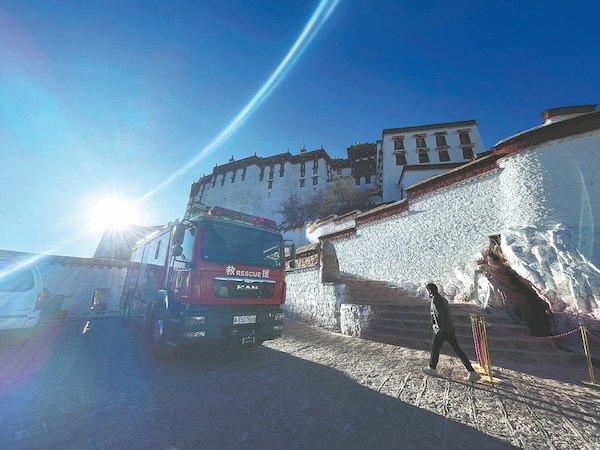Preserving the Potala Palace
Updated: 2025-04-22 By Palden Nyima and Daqiong in Lhasa (China Daily)  Print
Print 



In Lhasa, Xizang autonomous region, a fire truck stationed at the Potala Palace, ready to be pressed into service. [Photo by Palden Nyima/China Daily]
Firefighting measures
Enriched with an abundant collection of historical relics, it is of utmost importance to prevent damage from disasters, as well as theft.
A fire rescue brigade has been stationed in the place since 2005, and the buildings of the palace are equipped with alarms, smoke detectors, temperature sensors and imaging.
The Potala Palace has 889 electrical circuits in a smart electrical system. The brigade has 36 firefighters — commanders and combatants.
Sonam Tenzin, a firefighter, says they have fire extinguishers appropriate for the ancient buildings, include knapsack type, trolley type and water-mist devices.
"They may use dry powder, water, carbon dioxide, chemicals or other suppressants," says Sonam Tenzin.
A worker prepares the ropes for maintenance work. [Photo/Xinhua]
In addition to daily fire prevention work, they also lend helping hands to tourists.
"It's easy for tourists to get altitude sickness on the mountain. Their first thought is to seek the help of firefighters, which is another important task we perform," says Sonam Tenzin.
Apart from firefighters, monks and electricians also play important roles in palace protection.
Lobsang Chodrak, a caretaker of the monastic property, says the main responsibility of the monks is to protect and look after the external buildings and internal cultural relics of the Potala Palace.
"At the same time, we provide services to domestic and international tourists."
Once, there were places for boiling water and charging mobile phones, but not anymore, Lobsang Chodrak says.
"When monks leave home in the morning, they will cut off the power supply, and post a power outage symbol on the door when leaving after a power outage," he says.
Phuntsok Tsering, an electrician at the Potala Palace, says he needs to inspect each temple daily, and they check for abnormalities in each circuit section.
"Circuit risk is the biggest hidden fire danger. To prevent fires, we conduct daily inspections of each chapel one by one, and we walk 10,000 to 20,000 steps a day," he says.






